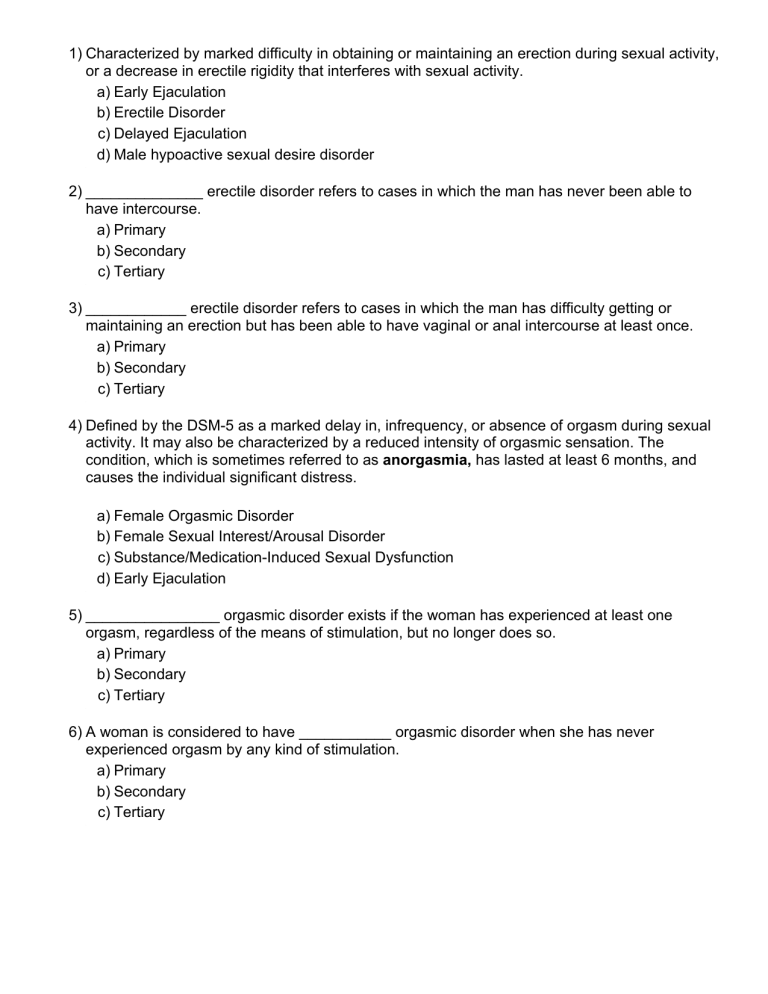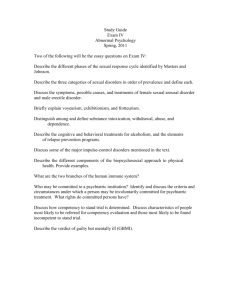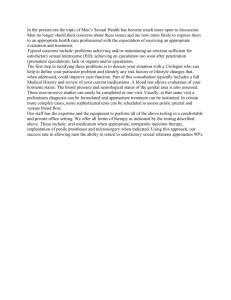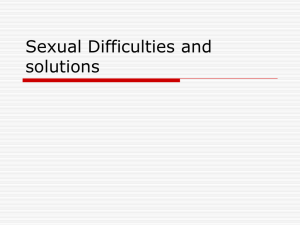
1) Characterized by marked difficulty in obtaining or maintaining an erection during sexual activity, or a decrease in erectile rigidity that interferes with sexual activity. a) Early Ejaculation b) Erectile Disorder c) Delayed Ejaculation d) Male hypoactive sexual desire disorder . 2) ______________ erectile disorder refers to cases in which the man has never been able to have intercourse. a) Primary b) Secondary c) Tertiary . 3) ____________ erectile disorder refers to cases in which the man has difficulty getting or maintaining an erection but has been able to have vaginal or anal intercourse at least once. a) Primary b) Secondary c) Tertiary . 4) Defined by the DSM-5 as a marked delay in, infrequency, or absence of orgasm during sexual activity. It may also be characterized by a reduced intensity of orgasmic sensation. The condition, which is sometimes referred to as anorgasmia, has lasted at least 6 months, and causes the individual significant distress. a) Female Orgasmic Disorder b) Female Sexual Interest/Arousal Disorder c) Substance/Medication-Induced Sexual Dysfunction d) Early Ejaculation . 5) ________________ orgasmic disorder exists if the woman has experienced at least one orgasm, regardless of the means of stimulation, but no longer does so. a) Primary b) Secondary c) Tertiary . 6) A woman is considered to have ___________ orgasmic disorder when she has never experienced orgasm by any kind of stimulation. a) Primary b) Secondary c) Tertiary . 7) Characterized by marked delay in ejaculation or marked infrequency or absence of ejaculation during partnered sexual activity. With this disorder, the man is unable to ejaculate, even though he has a firm erection and has had more than adequate stimulation. a) Early Ejaculation b) Male hypoactive sexual desire disorder c) Erectile Disorder d) Delayed Ejaculation . 8) Delayed Ejaculation - The severity of the problem may range from only occasional problems ejaculating a) Primary disorder b) Secondary disorder c) Tertiary disorder . 9) Delayed ejaculation - a history of never having experienced an orgasm a) Primary disorder b) Secondary disorder c) Tertiary disorder . 10) Persistent or recurrent ejaculation occurring within one minute of beginning partnered sexual activity and before the person wishes it. The diagnosis should take into account factors that affect the duration of the excitement phase, such as the person’s age, the novelty of the sexual partner, and frequency of sexual activity. a) Early Ejaculation b) Male hypoactive sexual desire disorder c) Delayed Ejaculation d) Erectile Disorder . 11) a) Female Orgasmic Disorder b) Female Sexual Interest/Arousal Disorder c) Substance/Medication-Induced Sexual Dysfunction d) Early Ejaculation . 12) Defined by the DSM-5 as a persistent or recurrent deficiency or absence of sexual fantasies and desire for sexual activity. An individual’s level of sexual desire may not be the problem; rather, the problem may be a discrepancy between the partners’ levels. The conflict may occur if one partner wants to have sexual relations more often than the other does. a) Substance/Medication-induced sexual dysfunction b) Genitopelvic pain/penetration disorder c) Male hypoactive sexual desire disorder d) Early ejaculation . 13) Occurs when the individual experiences considerable difficulty with vaginal intercourse and attempts at penetration. Pain is felt in the vagina, around the vaginal entrance and clitoris, or deep in the pelvis. There is fear and anxiety associated with anticipation of pain or vaginal penetration. The condition may be lifelong (present since the individual became sexually active) or acquired (began after a period of relatively normal sexual function). a) Substance/Medication-induced sexual dysfunction b) Male hypoactive sexual desire disorder c) Female orgasmic disorder d) Genitopelvic pain/penetration disorder . 14) Occurs after substance intoxication or withdrawal, or after exposure to a medication. The dysfunction may involve pain, impaired desire, impaired arousal, or impaired orgasm. Some substances/medications that can interfere with sexual functioning include alcohol, amphetamines, cocaine, opioids, sedatives, hypnotics, anxiolytics, antidepressants, antipsychotics, antihypertensives, and others. a) Substance/Medication-induced sexual dysfunction b) Genitopelvic pain/penetration disorder c) Male hypoactive sexual desire disorder d) Female sexual interest/arousal disorder .


